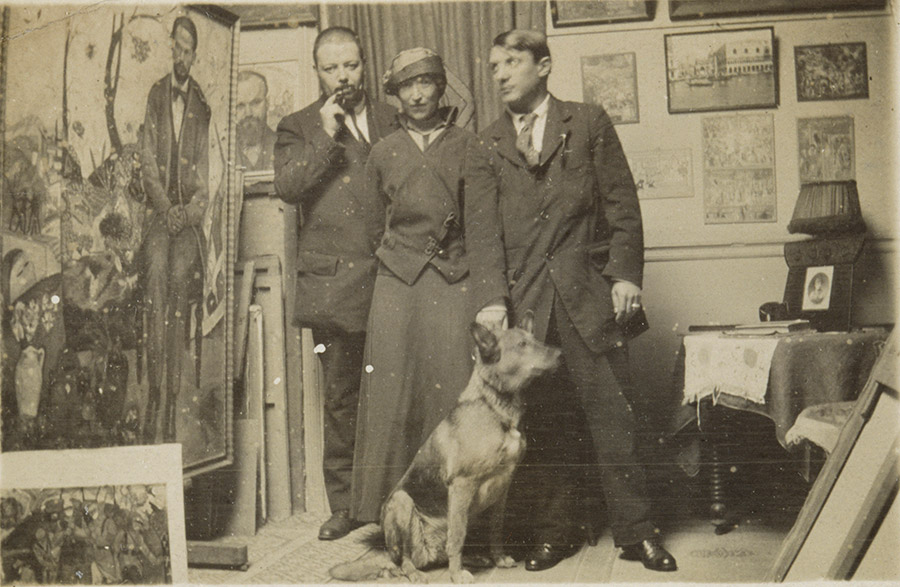A lunch with a magnetic atmosphere
Quoting another biography of Rivera by Loló de la Torriente published in 1959,[1] an article by Roberto Pliego[2] includes the following statement: “Loló de la Torriente writes that Picasso offered them lunch, in the midst of ‘a magnetic or electric atmosphere that was almost palpable.’ The day slipped by with a visit to Diego Rivera’s studio and dinner at a restaurant in Montparnasse, where Eva Gouel and Angelina Beloff joined them. At midnight, Picasso took out one of the photographs from his files—the reproduction of a guitar made of cardboard and paper—and in a gesture of warm welcome, wrote on the back: ‘For Diego Rivera, in full agreement.” The following morning, Picasso showed up at Diego’s studio with Guillaume Apollinaire; that same afternoon, they were joined by Ambroise Vollard, Cézanne’s former patron.”
In her memoir, Diego Rivera’s partner Angelina Beloff refers to this dinner, or to another gathering: “Picasso and Diego were good friends for a long time. He visited us and we also went to his studio, where he showed us his paintings. He was beginning to be famous then, and at one point, when we met him at a café, his wife (Eva Gouel) told us with admiration and a tinge of pride, ‘You know, Pablo just sold several paintings to the Russian millionaire Shchukin’s museum, and is starting to be well known.’ It was the beginning of Picasso’s fame. His wife fell seriously ill; I believe she had tuberculosis.”[3]
Indeed, in 1914 the Russian collector Sergei Shchukin had bought three Picassos from Kahnweiler: Cubist collages produced that same year, now held at the Hermitage Museum in Saint Petersburg.[4] They were the last pieces he purchased before the war.
[1] Loló de la Torriente, Memoria y razón de Diego Rivera, Mexico, Editorial Renacimiento, 1959. I was unable to access this biography, which appears to be very detailed. Unfortunately there is no English or French translation of this text.
[2] Roberto Pliego, Diego y Pablo, 2013, original Spanish available at https://www.nexos.com.mx/?p=15484, accessed 28/3/2020 “Escribe Loló de la Torriente que Picasso dispuso el almuerzo, en medio “de una atmósfera magnética o eléctrica que casi hubiera podido tocarse con las manos”. El día corrió entre una visita al estudio de Diego y la cena en un restaurante de Montparnasse a la que se sumaron Eva Gouel y Angelina Beloff. Al llegar la medianoche, Picasso tomó una de las fotografías de su archivo —la reproducción de una guitarra hecha a base de papel y cartón— y, en un gesto de calurosa bienvenida, escribió al reverso: “A Diego Rivera, en todo de acuerdo”... A la mañana siguiente, Picasso se presentó en el estudio de Diego junto a Guillaume Apollinaire; por la tarde, hizo su aparición Ambroise Vollard, el viejo protector de Cézanne.”
[3] Angelina Beloff, Memorias, Mexico, Ed. Universidad Nacional Autónoma de México-Coordinación de Difusión Cultural-Dirección de Literatura, 1986, p. 47 : “Picasso y Diego fueron buenos amigos durante mucho tiempo. Él nos visitaba y nosotros también íbamos a su taller, donde nos mostraba sus pintura. Ya empezaba a ser famoso y en una ocasión en que nos lo encontramos en un café, su mujer (Eva Gouel) nos dijo con admiración y un dejo de orgullo: “Saben, Pablo ha vendido cuadros al museo del millonario ruso Shchukin, y ya empieza a darse a conocer”. Era el comienzo de la gloria de Picasso. Su mujer cayó enferma de gravedad; creo que estaba tuberculosa.”
[4] Compotier avec grappes de raisin et poire coupée, Verre et poire coupée sur une table, La guinguette (Le jambon) also known as Couteau, fourchette, menu, bouteille, jambon, which can be viewed on the website http://www.collectionchtchoukine.com/artistes/pablo-picasso, accessed 29/3/2020.





 Summary
Summary